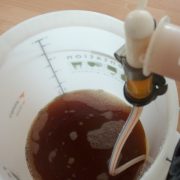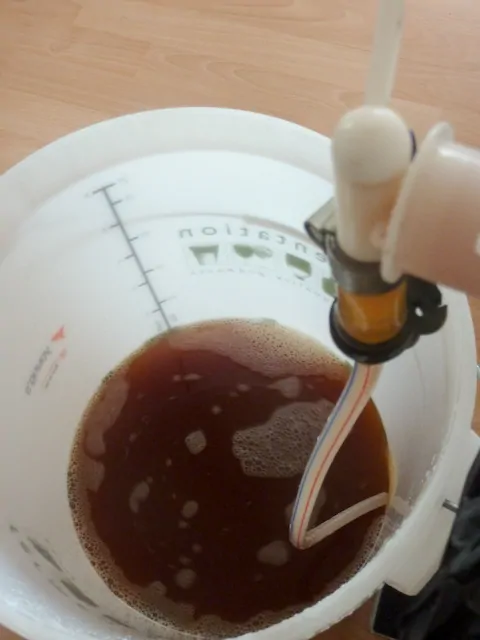Methods Of Wort Aeration & Oxygenation
Wort aeration is one of the parts of the brewing process that you don’t really think about after brewing a few batches, you just seem to do it instinctively every time you brew. It is an important part of the brewday that is so easy to do that there is really no reason not to do it.
Contrary to every other part of the brewing process where we don’t want to introduce any oxygen to the beer, aerating the wort just before pitching the yeast introduces oxygen that is essential for yeast growth and reproduction.
Aerating the wort is crucial in promoting yeast health and ensuring a strong fermentation with a short lag time (a quick start). Failing to introduce enough oxygen into the wort once the wort is chilled can lead to problems with extended time for the beer to start fermenting and beer failing to ferment out completely a dreaded stalled fermentation.
With all this in mind let’s take a look at some of the ways homebrewers can aerate the wort to make the best beer possible.
Table of Contents
When To Aerate The Wort?
At all other times, you should do everything you can to ensure air or oxygen doesn’t get in the beer. Every step of the process, you should aim to introduce as little air as possible.
It is only just prior to pitching the yeast that you will want to introduce oxygen into solution.
This means that after the boil and after chilling the beer to pitching temperature. This is when you want to get as much oxygen into the wort as possible.
What we do not want to do is add oxygen or air when the beer is still hot (hot side aeration) or after fermentation has started or is complete.
Wort Aeration Methods
There are multiple ways you can introduce oxygen into your beer, some will involve no equipment and just a little bit of effort, others will require some equipment and will increase the amount of oxygen you are able to introduce into the wort. First of all, let’s start with the easiest method and the one almost every home brew starts off with.
Splashing & Agitation
The easiest method of aerating the wort is to run the wort after chilling from the kettle into the fermenter from a height. This drop encourages splashing and foaming of the wort which introduces oxygen.
This can be as simple as opening a tap from the kettle and dropping the wort from a height into the fermenter or pouring the wort backwards and forwards between two sansited vessels. The more splashing and agitation the more oxygen will be introduced.
When I first started brewing I would pour the beer through a sanitised strainer which firstly would remove hops and other debris from the wort but secondly create a lot of agitation and splashing.
Another simple method is just before pitching your yeast to grab a sanitised jug and lift the beer out of the fermenter in the jug and pour it back in from a height. This can be done again and again as many times as necessary to get the wort nicely aerated.
If you use a hose to transfer wort to the fermenter a simple device called a siphon spray wort aerator can be attached to the hose. When the beer is transferred the siphon spray will diffuse the beer and introduce oxygen.
Pumps & Injection
The next methods of wort aeration rely on mechanical devices like pumps and air stones to aerate the wort. The biggest advantage of these types of device is that they enable you to get a much higher level of oxygen into the wort prior to pitching the yeast.
O2 injection is what most commercial breweries use to ensure high levels of oxygen for a swift and complete fermentation. Home brewers on the other hand who probably don’t need to use pure oxygen can inject air into the beer fairly simply.
Aquarium Pumps To Aerate Wort
A simple aquarium pump is a great way to dissolve oxygen in the beer and aerate the wort. Most aquarium pumps have HEPA filters that will remove contaminants and dust from the air and then inject it into the beer.
In operation, a simple aquarium pump with a length of small bore siphon tubing immersed in the wort will allow air from the room to be bubbled into the wort. Combine this with a diffusion stone and you can quickly get a really efficient wort aeration setup going.
I would highly encourage using a stainless steel diffusion stone rather than an aquarium stone. Firstly, because sanitising a stainless steel stone is much easier by simply boiling it in water for 10 minutes compared to the porous material aquarium stones are made of. Secondly, the aquarium stones I have used tend to break or wear very quickly.
It will take around 15 minutes of running the pump to get a good level of oxygen dissolved into solution but it is of course just a case of turning it on and keeping an eye on it.
Pure Oxygen Injection
Probably the method that will achieve the most aeration for the homebrewer is to inject pure oxygen into the wort. This will, of course, require a bottle of oxygen and a regulator.
If you want to go this route you will need to find a gas supplier to supply you the oxygen bottles and then a regulator to control the flow of gas coming from the bottle when you open the tap. Apart from this, it will be similar to using an aquarium pump, you can attach a hose and a diffusion stone and aerate the beer quickly and effectively with pure oxygen
Compared to pumping regular air with an aquarium pump, using pure oxygen will take a lot less time to achieve a much higher level of oxygen in solution in the wort. Around 2 – 3 minutes will be sufficient for a 5 gallon batch of beer.
The Effectiveness of Wort Aeration Methods
The most effective method of wort aeration is by using pure oxygen and injecting it into the wort, this is followed but injecting room air via an aquarium pump and then agitation or shaking air into the wort.
Choosing any one of these methods is more beneficial than doing nothing at all. In fact, research carried out by Wyeast found that of all the methods splashing was quite effective for the homebrewer. The table below shows the results of their research
| Method | DO ppm | Time |
| Siphon Spray | 4 ppm | 0 sec. |
| Splashing & Shaking | 8 ppm | 40 sec. |
| Aquarium Pump w/ stone | 8 ppm | 5 min |
| Pure Oxygen w/ stone | 0-26ppm | 60 sec (12ppm) |
It was concluded that pumping compressed air through a stone is not an efficient way to provide adequate levels of DO. Traditional splashing and shaking, although laborious, is fairly efficient at dissolving up to 8 ppm oxygen. To increase levels of oxygen, the carboy headspace can be purged with pure oxygen prior to shaking. The easiest and most effective method remains injecting pure oxygen through a scintered stone.
With this in mind I think it is fairly safe to say that aerating the wort needn’t be something to concern yourself about. It is however an effective step to have in your brewday to ensure maximum yeast health and quick fermentations.







Leave a Reply
Want to join the discussion?Feel free to contribute!